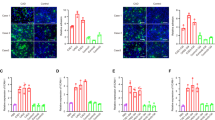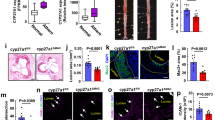Abstract
A genetic polymorphism in the human gene encoding connexin37 (CX37, encoded by GJA4, also known as CX37) has been reported as a potential prognostic marker for atherosclerosis1. The expression of this gap-junction protein is altered in mouse and human atherosclerotic lesions2: it disappears from the endothelium of advanced plaques but is detected in macrophages recruited to the lesions. The role of CX37 in atherogenesis, however, remains unknown. Here we have investigated the effect of deleting the mouse connexin37 (Cx37) gene (Gja4, also known as Cx37) on atherosclerosis in apolipoprotein E–deficient (Apoe−/−) mice, an animal model of this disease3. We find that Gja4−/−Apoe−/− mice develop more aortic lesions than Gja4+/+Apoe−/− mice that express Cx37. Using in vivo adoptive transfer, we show that monocyte and macrophage recruitment is enhanced by eliminating expression of Cx37 in these leukocytes but not by eliminating its expression in the endothelium. We further show that Cx37 hemichannel activity in primary monocytes, macrophages and a macrophage cell line (H36.12j) inhibits leukocyte adhesion. This antiadhesive effect is mediated by release of ATP into the extracellular space. Thus, Cx37 hemichannels may control initiation of the development of atherosclerotic plaques by regulating monocyte adhesion. H36.12j macrophages expressing either of the two CX37 proteins encoded by a polymorphism in the human GJA4 gene show differential ATP-dependent adhesion. These results provide a potential mechanism by which a polymorphism in CX37 protects against atherosclerosis.
This is a preview of subscription content, access via your institution
Access options
Subscribe to this journal
Receive 12 print issues and online access
$209.00 per year
only $17.42 per issue
Buy this article
- Purchase on Springer Link
- Instant access to full article PDF
Prices may be subject to local taxes which are calculated during checkout




Similar content being viewed by others
References
Yamada, Y. et al. Prediction of the risk of myocardial infarction from polymorphisms in candidate genes. N. Engl. J. Med. 347, 1916–1923 (2002).
Kwak, B.R., Mulhaupt, F., Veillard, N., Gros, D.B. & Mach, F. Altered pattern of vascular connexin expression in atherosclerotic plaques. Arterioscler. Thromb. Vasc. Biol. 22, 225–230 (2002).
Plump, A.S. et al. Severe hypercholesterolemia and atherosclerosis in apolipoprotein E–deficient mice created by homologous recombination in ES cells. Cell 71, 343–353 (1992).
Libby, P. Inflammation in atherosclerosis. Nature 420, 868–874 (2002).
Glass, C.K. & Witztum, J.L. Atherosclerosis. the road ahead. Cell 104, 503–516 (2001).
Osterud, B. & Bjorklid, E. Role of monocytes in atherogenesis. Physiol. Rev. 83, 1069–1112 (2003).
Wang, Q. et al. Premature myocardial infarction novel susceptibility locus on chromosome 1P34–36 identified by genomewide linkage analysis. Am. J. Hum. Genet. 74, 262–271 (2004).
Harris, A.L. Emerging issues of connexin channels: biophysics fills the gap. Q. Rev. Biophys. 34, 325–472 (2001).
Saez, J.C., Berthoud, V.M., Branes, M.C., Martinez, A.D. & Beyer, E.C. Plasma membrane channels formed by connexins: their regulation and functions. Physiol. Rev. 83, 1359–1400 (2003).
Goodenough, D.A. & Paul, D.L. Beyond the gap: functions of unpaired connexon channels. Nat. Rev. Mol. Cell Biol. 4, 285–294 (2003).
Simon, A.M., Goodenough, D.A., Li, E. & Paul, D.L. Female infertility in mice lacking connexin 37. Nature 385, 525–529 (1997).
Meir, K.S. & Leitersdorf, E. Atherosclerosis in the apolipoprotein-E–deficient mouse: a decade of progress. Arterioscler. Thromb. Vasc. Biol. 24, 1006–1014 (2004).
Patel, S.S., Thiagarajan, R., Willerson, J.T. & Yeh, E.T. Inhibition of α4 integrin and ICAM-1 markedly attenuate macrophage homing to atherosclerotic plaques in ApoE-deficient mice. Circulation 97, 75–81 (1998).
Becker, H.M., Chen, M., Hay, J.B. & Cybulsky, M.I. Tracking of leukocyte recruitment into tissues of mice by in situ labeling of blood cells with the fluorescent dye CFDA SE. J. Immunol. Methods 286, 69–78 (2004).
Eriksson, E.E. Mechanisms of leukocyte recruitment to atherosclerotic lesions: future prospects. Curr. Opin. Lipidol. 15, 553–558 (2004).
Wong, C.W., Christen, T. & Kwak, B.R. Connexins in leukocytes: shuttling messages? Cardiovasc. Res. 62, 357–367 (2004).
Puljung, M.C., Berthoud, V.M., Beyer, E.C. & Hanck, D.A. Polyvalent cations constitute the voltage gating particle in human connexin37 hemichannels. J. Gen. Physiol. 124, 587–603 (2004).
Evans, W.H. & Boitano, S. Connexin mimetic peptides: specific inhibitors of gap-junctional intercellular communication. Biochem. Soc. Trans. 29, 606–612 (2001).
Scemes, E., Duval, N. & Meda, P. Reduced expression of P2Y1 receptors in connexin43-null mice alters calcium signaling and migration of neural progenitor cells. J. Neurosci. 23, 11444–11452 (2003).
Kunapuli, S.P. & Daniel, J.L. P2 receptor subtypes in the cardiovascular system. Biochem. J. 336, 513–523 (1998).
Di Virgilio, F. et al. Nucleotide receptors: an emerging family of regulatory molecules in blood cells. Blood 97, 587–600 (2001).
Henttinen, T., Jalkanen, S. & Yegutkin, G.G. Adherent leukocytes prevent adenosine formation and impair endothelial barrier function by Ecto-5′-nucleotidase/CD73-dependent mechanism. J. Biol. Chem. 278, 24888–24895 (2003).
Fortes, F.S. et al. Modulation of intercellular communication in macrophages: possible interactions between GAP junctions and P2 receptors. J. Cell Sci. 117, 4717–4726 (2004).
Goldberg, G.S., Lampe, P.D. & Nicholson, B.J. Selective transfer of endogenous metabolites through gap junctions composed of different connexins. Nat. Cell Biol. 1, 457–459 (1999).
Goldberg, G.S., Moreno, A.P. & Lampe, P.D. Gap junctions between cells expressing connexin 43 or 32 show inverse permselectivity to adenosine and ATP. J. Biol. Chem. 277, 36725–36730 (2002).
Tran Van Nhieu, G. et al. Connexin-dependent inter-cellular communication increases invasion and dissemination of Shigella in epithelial cells. Nat. Cell Biol. 5, 720–726 (2003).
Leybaert, L. et al. Connexin channels, connexin mimetic peptides and ATP release. Cell Commun. Adhes. 10, 251–257 (2003).
Kwak, B.R. et al. Reduced connexin43 expression inhibits atherosclerotic lesion formation in low-density lipoprotein receptor-deficient mice. Circulation 107, 1033–1039 (2003).
Merhi-Soussi, F. et al. Interleukin-1 plays a major role in vascular inflammation and atherosclerosis in male apolipoprotein E-knockout mice. Cardiovasc. Res. 66, 583–593 (2005).
Acknowledgements
We thank E. Sutter, T. Dudez, I. Scerri and A. Angelillo-Scherrer for technical assistance and discussions. This work was supported by grants from the Swiss National Science Foundation (SNSF; PPOOA-68883 and 3100-067777), the Swiss University Conference Program 'Heart Remodeling in Health and Disease', the Novartis Foundation and the Roche Research Foundation (to B.R.K.); the SNSF (310000-107846/1 to M.C.); and the National Institutes of Health (GM18974 to D.A.G.).
Author information
Authors and Affiliations
Corresponding author
Ethics declarations
Competing interests
The authors declare no competing financial interests.
Supplementary information
Supplementary Fig. 1
Deletion of Cx37 enhances the transendothelial migration of macrophages. (PDF 1141 kb)
Rights and permissions
About this article
Cite this article
Wong, C., Christen, T., Roth, I. et al. Connexin37 protects against atherosclerosis by regulating monocyte adhesion. Nat Med 12, 950–954 (2006). https://doi.org/10.1038/nm1441
Received:
Accepted:
Published:
Issue Date:
DOI: https://doi.org/10.1038/nm1441
This article is cited by
-
Somatic GJA4 gain-of-function mutation in orbital cavernous venous malformations
Angiogenesis (2023)
-
Uncovering emergent phenotypes in endothelial cells by clustering of surrogates of cardiovascular risk factors
Scientific Reports (2022)
-
A new side-effect of sufentanil: increased monocyte-endothelial adhesion
BMC Anesthesiology (2021)
-
The role of connexin proteins and their channels in radiation-induced atherosclerosis
Cellular and Molecular Life Sciences (2021)
-
Pannexin 1 as a driver of inflammation and ischemia–reperfusion injury
Purinergic Signalling (2021)



